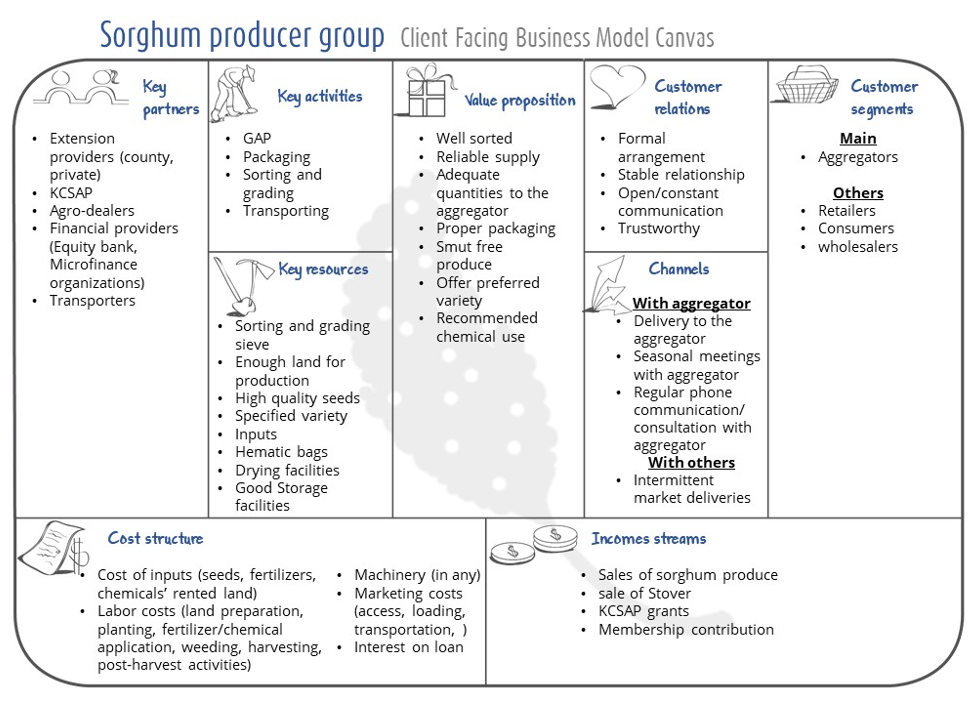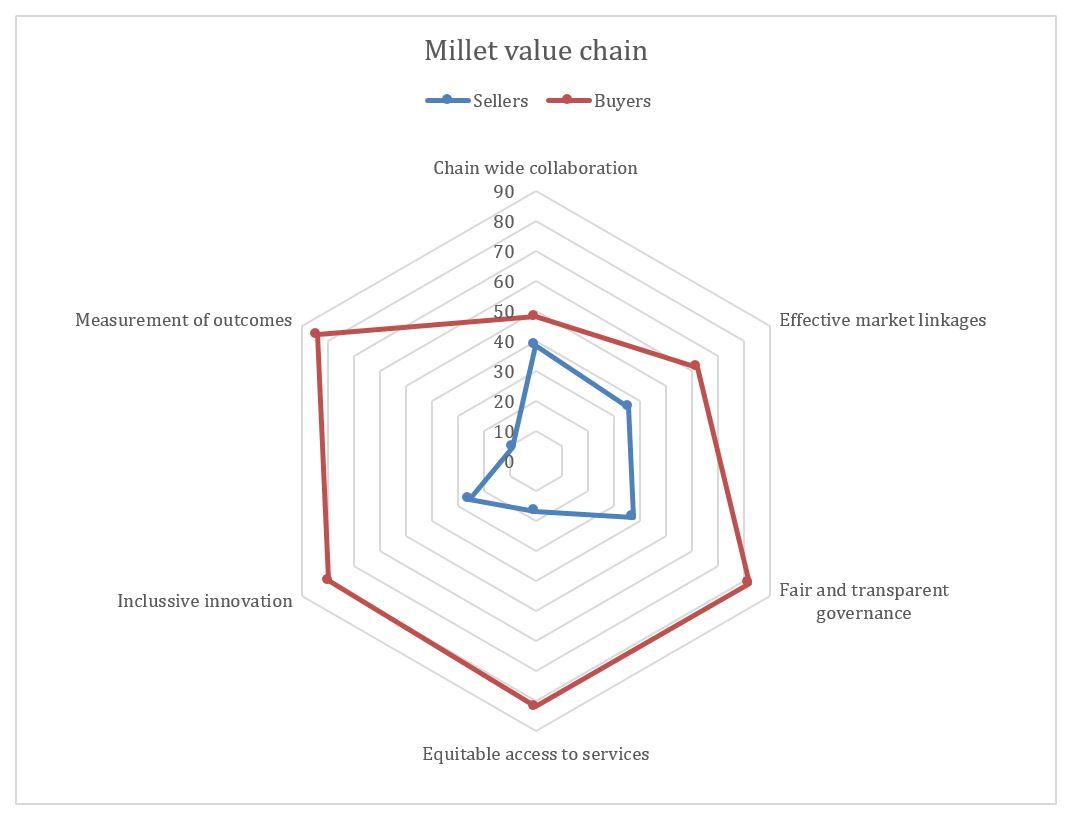From the Field Increasing business knowledge for sustainable and healthier diets in Kenya

LINK Methodology was created to bridge the smallholder farmers’ world and emerging markets. Since its launch in 2011, it has been implemented more than 80 times around the World, with farmer organizations from different levels of professionalization. However, how can a methodology like this contribute to improve nutrition and food security in food systems? A project in Kenya promises to give us insights on this.
The Kenya Climate Smart Agriculture Project (KCSAP) is a Government of Kenya project jointly supported by the World Bank. KCSAP is being implemented over a five-year period (2017-2022) under the framework of the Agriculture Sector Development Strategy (2010-2020) and National Climate Change Response Strategy (NCCRS, 2010). “Evaluating input and output market systems for CSA finger millet in Kericho, Irish potatoes in Bomet, and sorghum in West Pokot counties, in Kenya” is one of the KCSAP’s projects and The Alliance Bioversity-CIAT is training a team of this project on LINK as part of technical support in the implementation of the project at various stages.
The LINK training conducted in November 2020 brought together seven key project implementers (3 male and 4 female) from the Kenya Agricultural Livestock Research Centre (KALRO) and two private entities (Agrifood Economics Africa and TALUMA) to learn how the methodology works so that they can use it in the aforementioned project. Two staff from the Alliance of Bioversity and CIAT facilitated the training: Christine Chege and Kevin Onyango.


LINK Training Sessions
Increasing business knowledge
LINK is focused on inclusion as a bilateral activity to benefit all actors involved. The methodology leads its practitioners through a progressive path in which they can better understand their business and the environment in which it operates. A fundamental part of this path is The Double-facing Business Model Canvas (LINK’s Key Tool 2) that allows the participants to analyze at least three business models and their respective value proposition, key customers, among others: from the perspective of Farmer Organization (FO) towards the client, from the FO towards their members, and from the client towards the FO.
In the training, participants developed a Client facing business model canvas for sorghum and millet farmer organizations -Figure 1 shows the sorghum example.
Sorghum producer group Client Facing Business Model Canvas

Figure 1: Client facing business model canvas for sorghum farmer organization
The dialogue that LINK promotes between buyer and seller facilitate putting on the table issues that are difficult to address due to the asymmetries between these two actors. Figure 2 is an example of this: The New business model principles (LINK’s Key Tool 3) assess six critical areas to sustained inclusion of smallholder farmers: (1) Chain-wide collaboration; (2) Effective market linkages; (3) Fair and transparent governance; (4) Equitable access to services; (5) Inclusive innovation; and (6) Measurement of outcomes. Figure 2 shows results obtained from the training on LINK, developed by Christine Chege and Kevin Onyango (Alliance staff) with KCSAP team members and some partners from November 30 to December 2, 2020. As illustrated below there is a low level of inclusivity in the trading relationships between the buyer and the farmer groups involved in millet production and selling and this is depicted by the low scores on either side of the relationship and also a large discrepancy between scoring of the aggregators and that of the farmers. Efforts should be made to strengthen all the 6 principles of inclusivity.

Figure 2: New business model principles for millet value chain
This training is expected first, to build capacity of the project implementers so that they are able to implement the methodology within the project. Second, through implementation of LINK in the project, we expect improvements in incomes of the value chain actors, as well as food and nutrition security of rural households and urban consumers. The use of LINK methodology will strengthen the trading relationship between farmer organizations and input suppliers and with private sector buyers. With LINK, the relationship is also expected to be inclusive and sustainable.
Inclusion towards nutrition

Finger Millet is a native crop to the highlands of Kenya, Uganda and Ethiopia and has been widely grown traditionally in Africa for hundreds of years and widely consumed in Kenya. This grain not only better meets the nutritional needs of the family but also fulfils economic and agronomic requirements in a time of climate change (CWR, 2018). In fact, in this project we emphasize climate-smart Finger Millet.

Irish potato is the world’s fourth largest food crop after wheat, rice, and maize. It has high potential for addressing food insecurity, unemployment and low farm incomes due to its high productivity (Korir et. al.). Its high energy content and ease of production has made it an important component of urban agriculture, which provides jobs and food security to some 800 million people globally (Hoffler and Ochieng, 2008). Irish potato is among the top five most consumed commodities in Kenya.

Sorghum is Africa’s second most important cereal because it is the primary source of daily calories for 300 million sub-Saharan Africans. For Kenyan farmers, sorghum is also one of the few crops that grows well under local conditions because it is naturally drought- and heat-tolerant.
Around these three crops, the KCSAP project seeks to contribute to improved food and nutrition security and incomes through improved input systems and effective linkage with input and output markets. To meet this overall goal, the project will: (a) Characterize finger millet, Irish potato, and sorghum input and output market systems and value chain actors by gender; (b) Develop sustainable solutions for enhancing access to CSA finger millet, Irish potato, and sorghum inputs; (c) Develop solutions for creating sustainable output market linkages for CSA finger millet, Irish potato, and sorghum; (d) Implement the developed input and output market solutions with stakeholders; and (e) Validate and disseminate the project outputs. In this context, the LINK Methodology is expected to help increase the understanding of farmer groups involved in the production and selling of Finger Millet, Irish potatoes and Sorghum production and selling regarding their businesses and the environment in which these businesses operate. With this knowledge they will be able to participate in the design of solutions (LINK’s Key Tool 4) that allow them to move from the current business model to the desired business model enhancing resilience and coping mechanisms to climate change risks, as well as their nutrition and the nutrition of their consumers.
Training facilitators:

Christine Chege
Agri-Nutrition & Food Systems Specialist
[email protected]

Kevin Onyango
Research Assistant
[email protected]
References
- Crop Wild Relatives. 2018. The women finger millet advocates of Western Kenya. (Accessed on 9 December 2020)
- Crop Life International. 2020. #FOODHEROES. (Accessed on 9 December 2020)
- Korir CK, Gor CO, Odwori PO, Omunyin ME, Kibet N (2020). Factors Affecting Adoption of Value Addition Practices among Smallholder Irish Potato Farmers in Bomet County, Kenya. International Journal of Agricultural Marketing, 7(1): 225-232.
